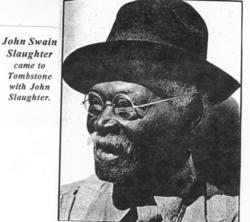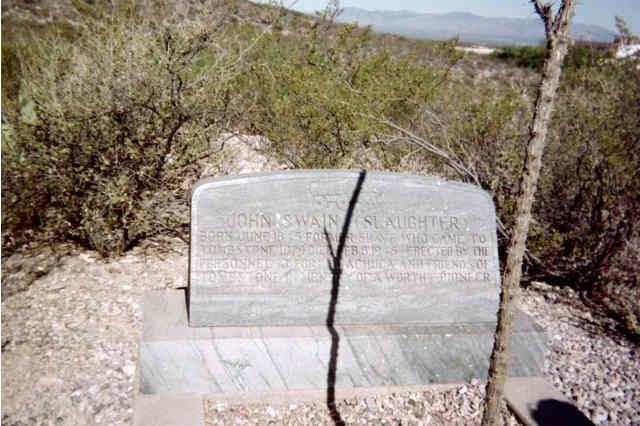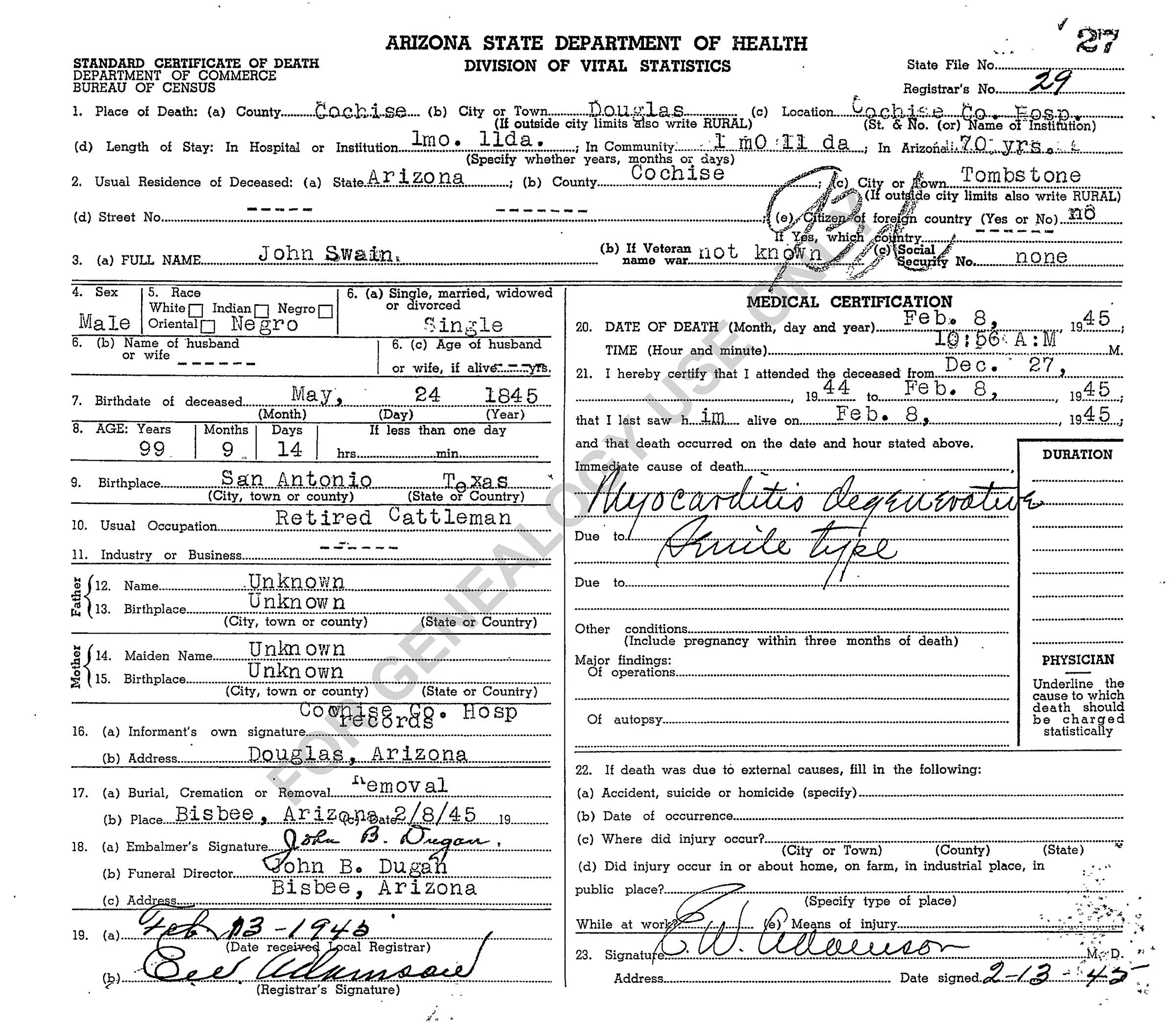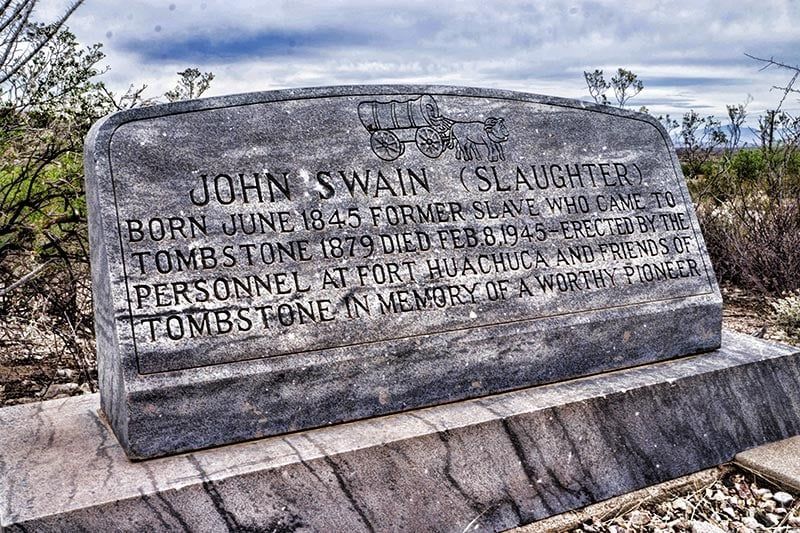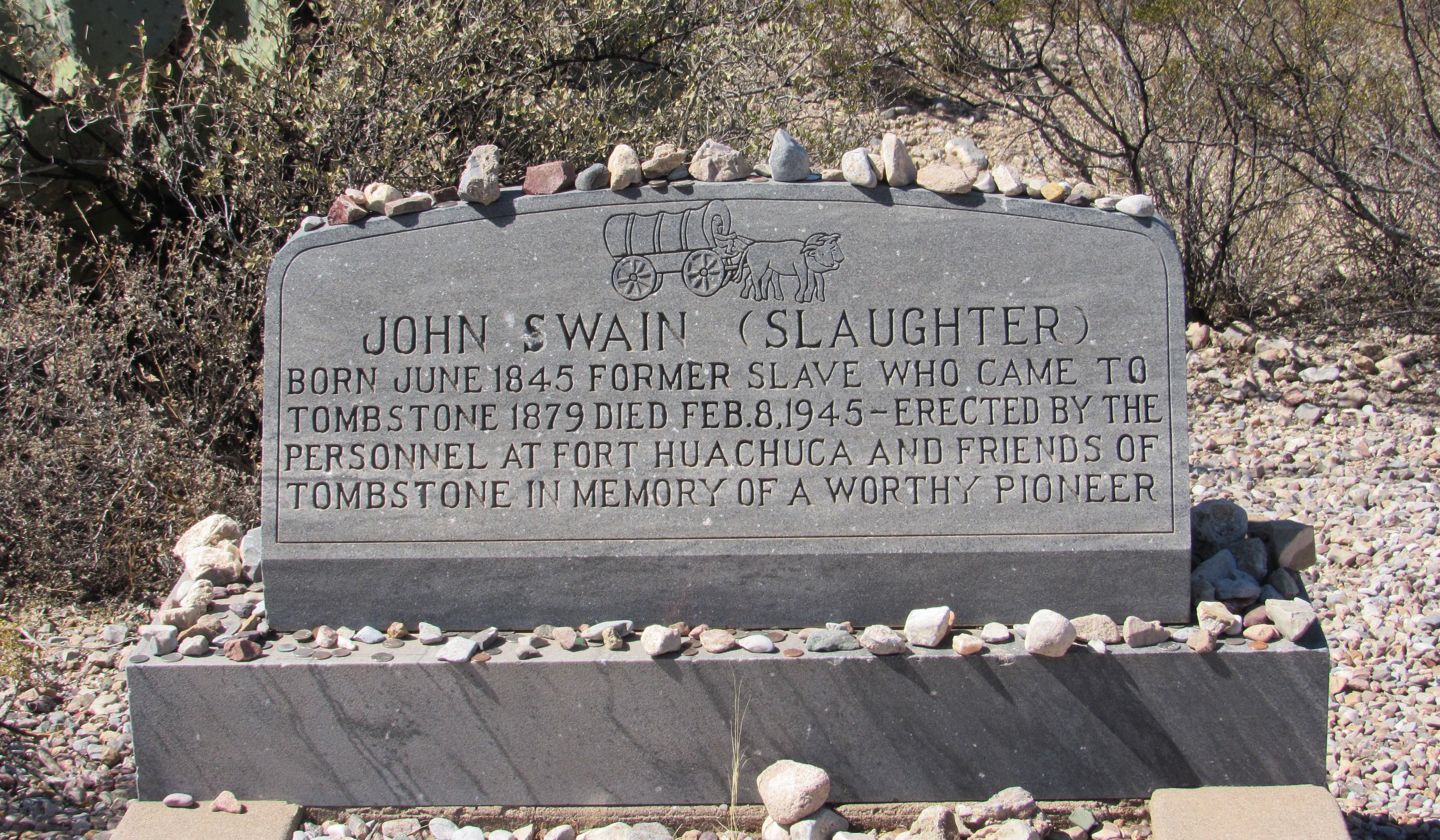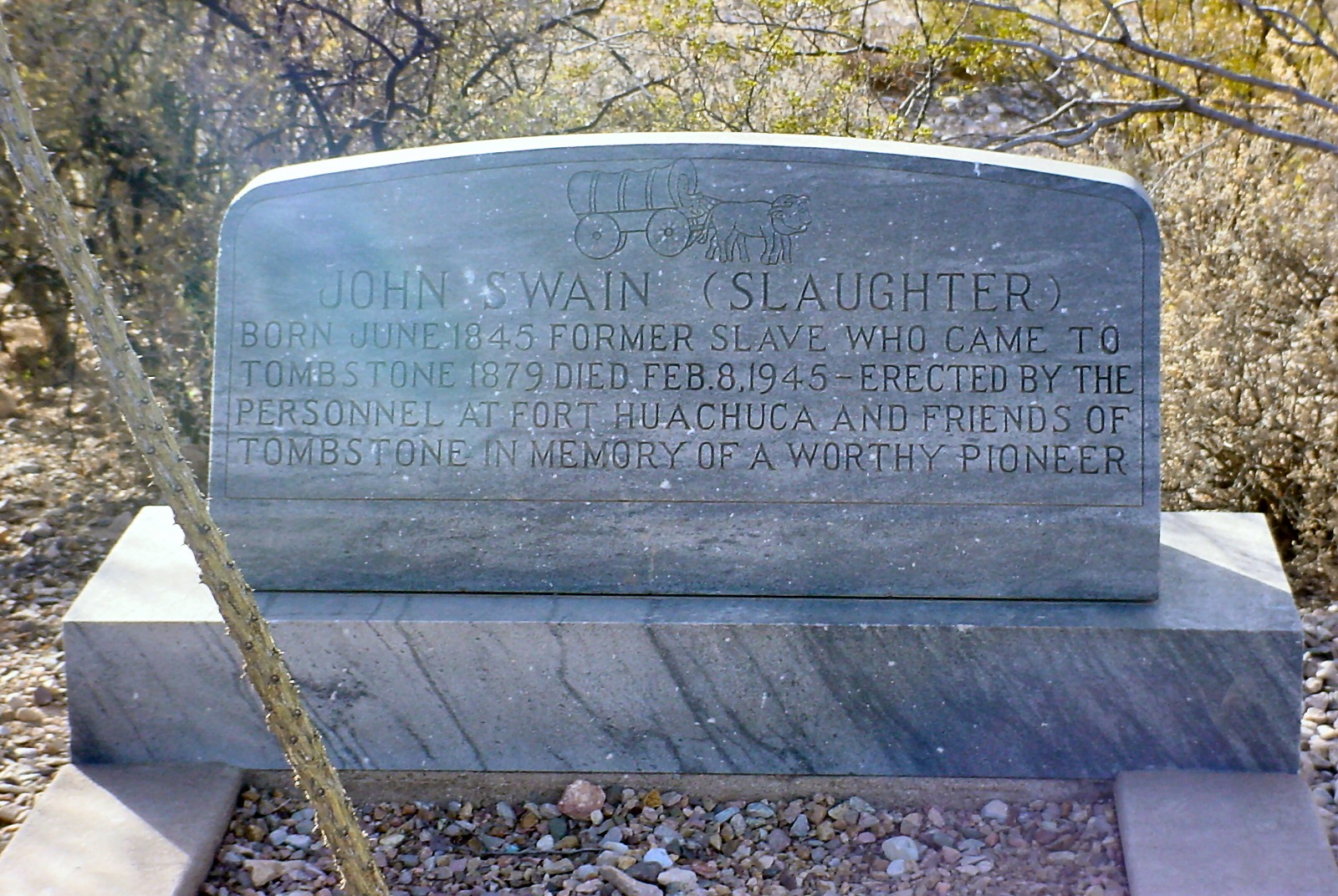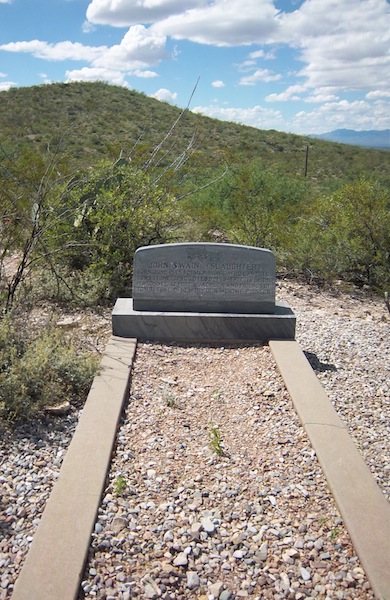Tombstone's Oldest Citizen, Ex-Slave Fills Last Grave in Town's Boot Hill
Fort Huachucans Pay Respect to Deceased Pioneer'
The last grave in Boot Hill cemetery. Tombstone Arizona, was filled a few weeks ago by the body of a 99 year old Negro, whose life in the town has spanned the most thrilling days of the
community’s history. John Swain, ex-slave, lived in Tombstone in 1879, when the first grave was dug in Boot Hill. The grave will be filled on Feb. 15, 1945, will be the last to go down in that spot. His death marks the end of the last consort of the roughest bunch of gun-slingers who died with their boots on and whose reckless courage helped to give to the West its reputation of being the land “where men are men ”The only continuous colored resident of the town for the past 35
years, Mr. Swain held the respect and affection of the community. His funeral was attended by the Mayor of Tombstone and other dignitaries, from nearby communities, including Col. E. N. Hardy, Post Commander, Fort Huachuca. The Post’s Military band played and very impressive
rites were conducted with dignity and reverence. John Swain came to Arizona over 70 years ago with John Slaughter, cattle baron, from Texas. He worked for the Slaughter family until well
up in the 20th century, when he acquired land of his own and started a small ranch. Mr. Slaughter, a figure of great historical importance in this part of the country, was sheriff of
Tombstone for many years and John Swain was frequently used as one of his deputies in apprehending the “bad-men” who attempted to terrorize the community. Many of those
same men now lie under the rocky soil of Boot Hill, where Swain is taking his eternal rest.
Independent until his last days; Mr. Swain kept his little cottage behind the Court House spotlessly clean; he tended his own garden plot; and he walked pridefully about the streets of Tombstone as he had walked about those' streets in the halcyon days of the 80’s. So independent was he that he had even put aside $IOO of his own small pension money to provide for his burial. It is at his own request that his remains are buried in Boot Hill, near those whom he had known during the early days when he was one of the hardest riding cowboys in the
region.
Was Symbol of Era
In outliving all of his contemporaries, John Swain became a symbol of an era and his death marked the end of that era. Despite the pomp of his funeral, and the significance of his democratically lived life, John Swain’s body lies in a grave which has only a temporary marker over it, which the winds of the changing seasons will destroy within a few months.
Will Build Memorial
Because of what the life of John Swain means in the history of the Southwest, Fort Huachuca has taken it upon itself that the tradition of his life will not be lost with the fading of the ink-marked sign over his grave. A permanent monument, to be known as the John Swain Memorial
monument, will be erected over that grave, to preserve, for generations to come, the knowledge of the fact that a Negro ex-slave had been an integral part of the frontier life of the community of Tombstone, and that he was the last to carry the tradition of that life into historic Boot Hill cemetery—that his death marked finish to one of the most romantic chapters of Western life.
Major John H. Healey, Post Claims officer, and long time owner of a ranch in the Tombstone district, heads a committee to build such a monument for John Swain. Contributions have already been made, both at the Fort and in Tombstone
for the erection of such a monument.
The splendor of the monument will depend upon the amount of contributions raised for its erection; therefore generous contributions are sought from all of the Fort’s citizens
for the John Swain Memorial.
How to Contribute
All contributions to the erection of the John Swain Memorial are to be reported to Major Healey. Soldiers may give their contributions to their company or detachment commanders; civilians’ contributions are to be turned in to their department heads; and those from school children are
to be made to the school principals.
Direct contributions will be accepted by Major Healey at his office in Post Headquarters annex.
Even though many or us are only temporary citizens of the great Southwest, let us not forget those who fought nature and hostile people to make and keep this part of our Nation peaceful and law-abiding.
The Apache sentinel. March 02, 1945
Tombstone's Oldest Citizen, Ex-Slave Fills Last Grave in Town's Boot Hill
Fort Huachucans Pay Respect to Deceased Pioneer'
The last grave in Boot Hill cemetery. Tombstone Arizona, was filled a few weeks ago by the body of a 99 year old Negro, whose life in the town has spanned the most thrilling days of the
community’s history. John Swain, ex-slave, lived in Tombstone in 1879, when the first grave was dug in Boot Hill. The grave will be filled on Feb. 15, 1945, will be the last to go down in that spot. His death marks the end of the last consort of the roughest bunch of gun-slingers who died with their boots on and whose reckless courage helped to give to the West its reputation of being the land “where men are men ”The only continuous colored resident of the town for the past 35
years, Mr. Swain held the respect and affection of the community. His funeral was attended by the Mayor of Tombstone and other dignitaries, from nearby communities, including Col. E. N. Hardy, Post Commander, Fort Huachuca. The Post’s Military band played and very impressive
rites were conducted with dignity and reverence. John Swain came to Arizona over 70 years ago with John Slaughter, cattle baron, from Texas. He worked for the Slaughter family until well
up in the 20th century, when he acquired land of his own and started a small ranch. Mr. Slaughter, a figure of great historical importance in this part of the country, was sheriff of
Tombstone for many years and John Swain was frequently used as one of his deputies in apprehending the “bad-men” who attempted to terrorize the community. Many of those
same men now lie under the rocky soil of Boot Hill, where Swain is taking his eternal rest.
Independent until his last days; Mr. Swain kept his little cottage behind the Court House spotlessly clean; he tended his own garden plot; and he walked pridefully about the streets of Tombstone as he had walked about those' streets in the halcyon days of the 80’s. So independent was he that he had even put aside $IOO of his own small pension money to provide for his burial. It is at his own request that his remains are buried in Boot Hill, near those whom he had known during the early days when he was one of the hardest riding cowboys in the
region.
Was Symbol of Era
In outliving all of his contemporaries, John Swain became a symbol of an era and his death marked the end of that era. Despite the pomp of his funeral, and the significance of his democratically lived life, John Swain’s body lies in a grave which has only a temporary marker over it, which the winds of the changing seasons will destroy within a few months.
Will Build Memorial
Because of what the life of John Swain means in the history of the Southwest, Fort Huachuca has taken it upon itself that the tradition of his life will not be lost with the fading of the ink-marked sign over his grave. A permanent monument, to be known as the John Swain Memorial
monument, will be erected over that grave, to preserve, for generations to come, the knowledge of the fact that a Negro ex-slave had been an integral part of the frontier life of the community of Tombstone, and that he was the last to carry the tradition of that life into historic Boot Hill cemetery—that his death marked finish to one of the most romantic chapters of Western life.
Major John H. Healey, Post Claims officer, and long time owner of a ranch in the Tombstone district, heads a committee to build such a monument for John Swain. Contributions have already been made, both at the Fort and in Tombstone
for the erection of such a monument.
The splendor of the monument will depend upon the amount of contributions raised for its erection; therefore generous contributions are sought from all of the Fort’s citizens
for the John Swain Memorial.
How to Contribute
All contributions to the erection of the John Swain Memorial are to be reported to Major Healey. Soldiers may give their contributions to their company or detachment commanders; civilians’ contributions are to be turned in to their department heads; and those from school children are
to be made to the school principals.
Direct contributions will be accepted by Major Healey at his office in Post Headquarters annex.
Even though many or us are only temporary citizens of the great Southwest, let us not forget those who fought nature and hostile people to make and keep this part of our Nation peaceful and law-abiding.
The Apache sentinel. March 02, 1945
Sponsored by Ancestry
Advertisement
Explore more
Sponsored by Ancestry
Advertisement
